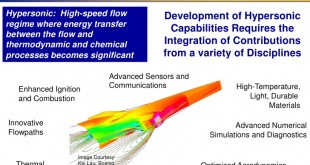Introduction: In the ever-evolving landscape of modern warfare, a new and formidable threat has emerged – Tunnel Warfare. Gone are the days when conflicts were fought solely on open battlefields; today, the battleground extends beneath the Earth’s surface, presenting unique challenges and opportunities for military strategists. As nations grapple with …
Read More »Advancing National Security: The Technological Frontier of Energetics Innovation
Introduction: In the ever-evolving landscape of national security, maintaining technological superiority is imperative. Recognizing this challenge, the United States has embarked on a pivotal strategic initiative: the National Energetics Plan. This visionary plan not only focuses on developing next-generation capabilities but also aims to fortify the resilience and adaptability of …
Read More »Revolutionizing the Battlefield: 3D Printing’s On-Demand Arsenal for the Modern Military
Introduction: In the ever-evolving landscape of modern warfare, technology is a key driver of innovation. Among the groundbreaking advancements, 3D printing has emerged as a game-changer, providing the military with unprecedented capabilities. 3D printing or additive manufacturing is ongoing revolution in manufacturing with its potential to fabricate any complex object …
Read More »Navigating Turbulence: The European Economic Security Strategy Amid Geopolitical Tensions
In the dynamic landscape of international relations, Europe finds itself at a crossroads, grappling with rising geopolitical tensions within the continent and the broader rift between the West and China. Within Europe, the ongoing war in Ukraine and its ripple effects on energy markets and supply chains have cast a …
Read More »Hypersonic Technologies Race: Overcoming Gaps, Obstacles, and Technological Challenges in the Pursuit of Hypersonic Weapons
Introduction: The era of hypersonic flight has dawned upon us, ushering in a new age of aerospace technology. Hypersonic refers to aircraft, missiles, rockets, and spacecraft that can reach speeds through the atmosphere faster than Mach 5, which is nearly 4,000 miles per hour. This paradigm shift in aviation has …
Read More »Powering the Battlefield: Exploring the Military Power Technologies and Solutions Market
In the dynamic and evolving arena of modern warfare, military power technologies and solutions play a pivotal role in ensuring operational preparedness, tactical agility, and strategic superiority. From powering sophisticated weaponry to sustaining troops in remote outposts, these technologies form the backbone of modern military operations. Military power solutions are …
Read More »Pioneering the Future: Technological Breakthroughs Revolutionizing Age-Related Disease Management
In the relentless pursuit of healthier, longer lives, groundbreaking technologies are emerging as beacons of hope, offering novel approaches to tackle age-related diseases. As the global population ages, the urgency to address conditions such as Alzheimer’s, cardiovascular diseases, and arthritis has sparked a wave of innovation that transcends traditional medical …
Read More »Revolutionizing Warfare with AI: DARPA Invests in Strategic Chaos Engine for Planning, Tactics, Experimentation and Resiliency (SCEPTER)
The U.S. Defense Advanced Research Projects Agency (DARPA) is spearheading a groundbreaking initiative to harness the power of artificial intelligence (AI) in strategic battlefield decision-making. With an investment of millions in research funding, DARPA’s Strategic Chaos Engine for Planning, Tactics, Experimentation and Resiliency (SCEPTER) program aims to develop AI technology …
Read More »Illuminating Perspectives: Exploring the Wonders of Computer Vision Technology and Applications
Introduction: In the realm of artificial intelligence, computer vision stands out as a transformative technology, empowering computers to perceive and interpret the visual world around us. By harnessing the power of machine learning and image processing techniques, computer vision systems can extract meaningful information from digital images and videos, bridging …
Read More »Plasma technologies: Revolutionizing Space, Defense, and Beyond
In the realm of matter, plasma stands out as the fourth state, distinct from solids, liquids, and gases. A fascinating entity, plasma arises when gas becomes ionized, where at least one electron breaks free from atoms or molecules. This ionization transforms the gas into an electrically conductive medium, responding robustly …
Read More » International Defense Security & Technology Your trusted Source for News, Research and Analysis
International Defense Security & Technology Your trusted Source for News, Research and Analysis



